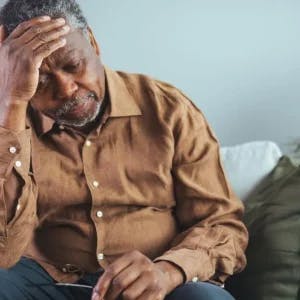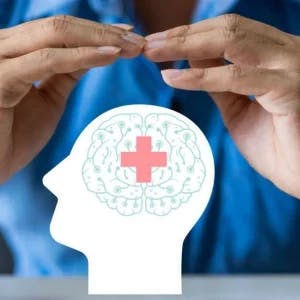Hemiplegia and hemiparesis are two common physical effects of stroke. Since these two conditions have similar-sounding names, it can be easy for survivors to confuse the two terms. However, these conditions are quite different and have different implications for a stroke survivor’s daily life and independence.
In this article, we will review the differences between hemiplegia vs hemiparesis as well as treatment options for both conditions. Although the symptoms are different, both hemiparesis and hemiplegia share the same underlying cause. This means some treatments will overlap.
Table of contents
Definition of Hemiplegia vs. Hemiparesis
The term “hemi” in both hemiplegia and hemiparesis refers to symptoms that occur in one half of the body. Therefore, both conditions affect either the patient’s left or right side, depending on where the stroke occurred.
The term “plegia” is from a Greek word that originally meant “to strike” and was used to describe a stroke. In modern medicine, the word is mostly used to refer to paralysis. Therefore, hemiplegia means paralysis of one-half of the body, usually as a result of stroke. However, traumatic brain injury, spinal cord injury, and other neurological conditions can also cause hemiplegia.
In contrast, the term “paresis” originates from a Greek word meaning “to let go.” While this sounds a lot like paralysis, “paresis” actually refers to more mild weakness. This means that hemiparesis refers to weakness on one side of the body.
To summarize these definitions, hemiparesis causes significant weakness in one half of the body while hemiplegia causes paralysis. For example, a person with hemiparesis may retain some movement of their limbs on the affected side. However, a survivor affected by hemiplegia would not be able to move the affected side at all.
Causes of Hemiplegia vs. Hemiparesis
Both hemiplegia and hemiparesis share the same root cause: decreased communication between the brain and the muscles. In fact, hemiplegia is simply a more severe form of hemiparesis. To better understand hemiplegia vs hemiparesis, it will help to know how the brain and muscles interact.
Certain parts of the brain, such as the primary motor cortex, send a complex array of signals to the muscles. These signals enable you to move on command. However, when a stroke damages these areas of the brain, movement-related signals become interrupted. As a result, the muscles do not receive or respond appropriately to these movement signals.
It is helpful to note that the brain is divided into two hemispheres, or halves. Each hemisphere of the brain controls movement on the opposite side of the body. This means that a right hemisphere stroke can result in left hemiplegia or hemiparesis. Similarly, a left hemisphere stroke can lead to right hemiplegia or hemiparesis.
The difference between the development of hemiplegia vs. hemiparesis depends largely on the area of the brain affected and the severity of the stroke. If tissue damage was somewhat mild, some signals from the brain may still reach the muscles, although these signals will be weaker. Therefore, while the person may have difficulty moving their arm or leg, it is still possible to move. This is classified as hemiparesis.
If, on the other hand, the survivor experienced a severe stroke, the neural connections will be completely inhibited. This essentially leaves the muscles in a state of paralysis. Keep in mind that the muscles themselves are not injured, but rather they are not receiving movement signals from the brain.
These differences between hemiplegia vs. hemiparesis highlight the importance of timely detection and treatment of stroke. Fast treatment can help restore blood flow to the brain and minimize stroke secondary effects. Knowing the different stroke warning signs can help ensure that you or a loved one receive timely treatment after stroke onset.
Fortunately, the brain possesses a remarkable ability to repair or regenerate neural connections and improve or restore motor function. This healing process is known as neuroplasticity, which we will discuss next. Harnessing this ability can help stroke patients overcome both hemiparesis and hemiplegia after stroke.
How Neuroplasticity Improves Function After Stroke
Neuroplasticity refers to the brain’s ability to heal itself and restore function by forming new neural connections in response to certain stimuli. This allows the brain to reassign functions to different areas of the brain when necessary.
For example, after a stroke the parts of the brain that normally control movement might be damaged. Thanks to neuroplasticity, however, the brain can transfer the functions previously controlled by the injured area to other, undamaged regions. This occurs through the rewiring of the neural connections that were inhibited due to the stroke.
You can activate neuroplasticity through massed practice of rehab exercises. For instance, practicing high repetitions of leg exercises can help strengthen the neural connections that control leg movement. With time and consistency, this can improve a survivor’s ability to walk as new connections are formed and the muscles become stronger.
While exercise is a necessary aspect of recovery from stroke, this can be difficult for those affected by hemiparesis or hemiplegia. Still, there are effective ways to activate neuroplasticity, even when active movement is minimal or inefficient. To help you get started, we will discuss some of these methods in the next section.
Treatments for Hemiparesis vs Hemiplegia
Due to the increased magnitude of weakness, patients with hemiplegia will likely need to take extra steps in their recovery to help restore function. However, both individuals with hemiparesis and hemiplegia can recover movement and strength to some degree.
While there are many different exercise guidelines after stroke, it is important to talk with your rehab team to create a plan that is optimal for you. Your physical, speech, and occupational therapists can help provide exercises that directly address your unique symptoms and goals.
To help you get started on the road to recovery, we will review different types of exercises and treatments that address hemiplegia and hemiparesis after stroke. Four examples of these exercises and treatments include:
1. Passive Rehab Exercise
Individuals with hemiparesis or hemiplegia can maintain flexibility and promote muscle activation in their affected limbs by practicing passive exercises. This simply means assisting your affected side with your non-affected side to move your limb through its full range of motion. If this is difficult, you can have a caregiver help you with this.
Although you are not moving your limb actively, passive exercise still helps promote neuroplasticity and encourages the rewiring of new connections. Additionally, passive exercise can help prevent other complications like contractures. This helps to ensure that you will be ready to transition to active exercises when able.
It is important to be patient throughout the rehabilitation process as recovery can be slow and frustrating at times. It takes the consistent, dedicated practice of passive exercise to regain mobility, but improvement is always possible.
2. Active Rehab Exercise
Active rehab exercise refers to exercises that are performed using active muscle contraction. This means you are performing the motion independently or with minimal assistance. Moving your muscles even just a small amount can directly activate neuroplasticity and promote the rewiring of neural connections.
Individuals with hemiparesis after stroke may be able to perform active exercise right away to help increase muscle strength and promote neuroplasticity. Or, individuals with hemiparesis or hemiplegia may need to start with passive exercise and work up to active exercise.
When stroke patients stop using their affected side due to hemiplegia or hemiparesis, the muscles often lose mass and strength. This progressive weakness is called muscle atrophy. Not only does active exercise help activate neuroplasticity, but it also helps strengthen the affected muscles. This can help reverse atrophy and increase motor function for individuals affected by weakness or paralysis after stroke.
Deciding whether passive or active exercise is right for you can feel overwhelming, so make sure to consult your rehab team. Your team of therapists can help guide you on your recovery journey to help you reach your goals.
3. Electrical Stimulation
Electrical stimulation, sometimes referred to as e-stim, can be a beneficial addition to a survivor’s stroke recovery plan. This includes survivors affected by hemiplegia and hemiparesis as e-stim can provide input to the muscles, nerves, and brain to encourage neuroplasticity.
There are many kinds of electrical stimulation available, and each has different benefits. E-stim can be used to trigger a muscle contraction, reduce pain after stroke, and improve active muscle control. Additionally, electrical stimulation can help with foot drop after stroke to improve a survivor’s walking.
Talk with your doctor and rehab team to determine if electrical stimulation is appropriate for your symptoms and goals. When used safely, this can be a helpful addition to active and passive exercise to promote recovery from hemiplegia or hemiparesis.
4. Mirror Therapy
Finally, mirror therapy is a great way to promote recovery from hand weakness or paralysis after stroke. This treatment involves placing a mirror over your affected hand and doing hand therapy exercises with your non-affected hand while watching the mirror. This “tricks” your brain into thinking that you are moving your affected hand and helps rewire the brain.
To demonstrate how mirror therapy can be beneficial for stroke rehab, check out this unique hand paralysis story. This story describes how a woman combined mirror therapy with paralysis exercise to help her husband regain movement in his paralyzed hand after stroke.
Understanding the Difference Between Hemiplegia vs Hemiparesis
While hemiplegia and hemiparesis sound very similar, these terms refer to different secondary effects of stroke. Hemiplegia refers to paralysis on one side of the body after a stroke while hemiparesis refers to weakness on one side. Both problems are caused by impaired communication between the brain and the muscles.
Fortunately, you can treat both hemiplegia and hemiparesis by engaging neuroplasticity through therapy exercises. Survivors with hemiplegia will need to activate neuroplasticity through passive exercises initially until active muscle contraction improves. Survivors with hemiparesis may be able to engage in active rehab exercises right away or may need to start with passive exercises also.
Regardless of what type of exercise you are capable of, high repetition and consistency are key for recovery. With consistent rehabilitation, you can restore the neural connections between your brain and muscles to improve your function. This will lead to improved mobility and a greater recovery after stroke.















